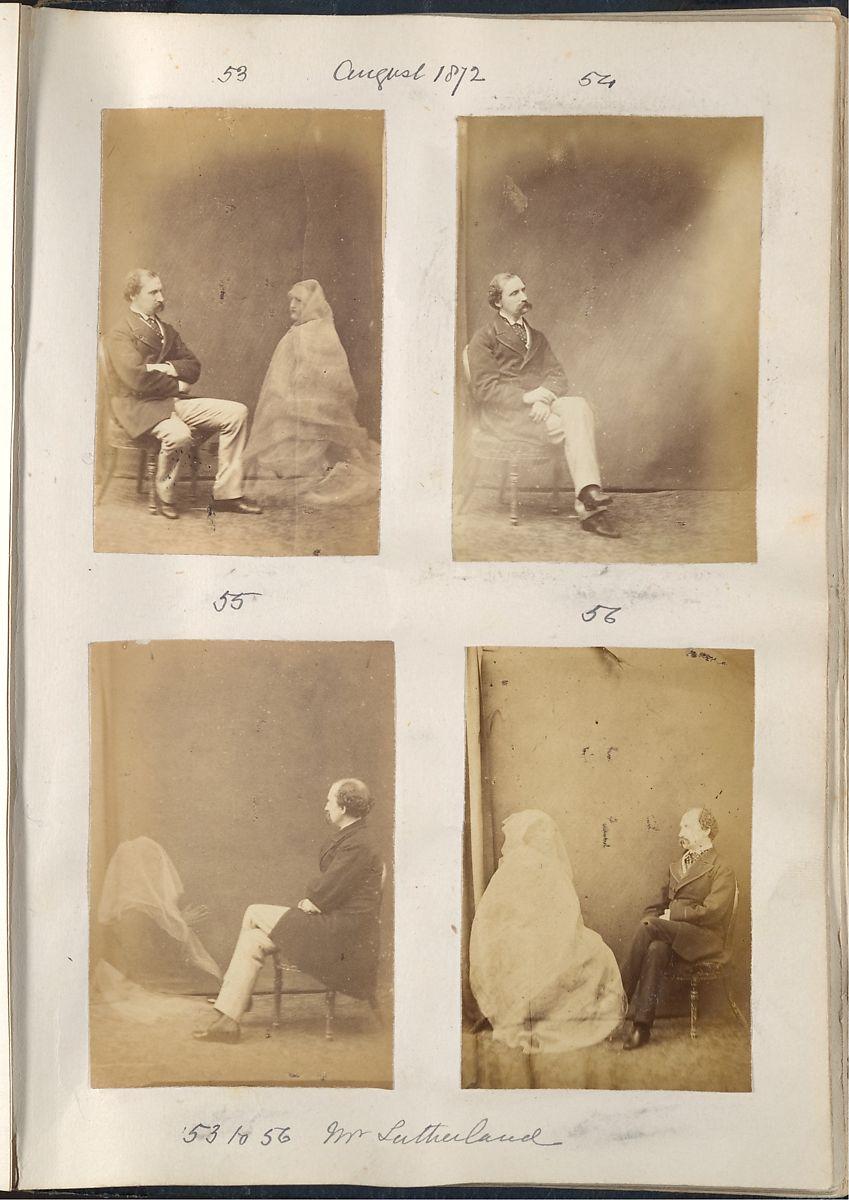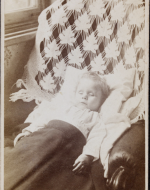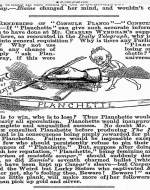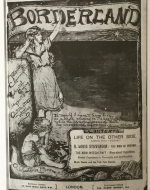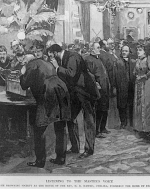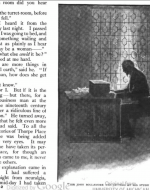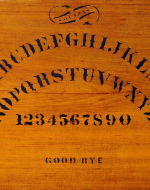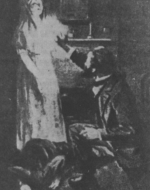Created by Avery Curran on Mon, 06/15/2020 - 11:09
Description:
This gallery has been created to explore how the Victorian relationship with the dead evolved with the emergence of new technologies. It will explore how culture expanded to include developments in photography, telegraphy and sound, which brought new ways for the Victorians to keep their loved ones 'alive'. Photographic images and sound recordings of the dead are included, along with examples of ‘automatic writing’ to illustrate how technology affected Victorians’ ideas about the dead and the ways that they sought connection with deceased loved ones. The gallery also reviews the advent of commercialisation and how sceptics used technology to attempt to disprove some new attempts at communicating with the dead.
1. Frederick Hudson, Album of Spirit Photographs, albumen silver prints from glass negatives (1872), Metropolitan Museum of Art
This 1872 album of spirit photographs is typical of the Victorian use of photography to maintain contact with the dead. The photographer was Frederick Hudson, one of the most famous (and commercially successful) spirit photographers of the period. In these photographs, a living male subject sits in a chair in a variety of poses, looking towards what looks like a ghostly figure. The figure appears as a woman shrouded in white, slightly blurred and translucent. These images were likely taken using ‘double exposure’, a new photographic technique that involved capturing two separate images on the same glass plate.
2. Artist unknown, Alfred Owen Laid Out After Death, carte-de-visite photograph (date unknown), Victoria and Albert Museum
This photograph depicts the corpse of a young boy named Alfred Owen. He has been posed as though asleep, his eyes closed, in an armchair. Postmortem photography was often used to commemorate the dead as it provided a visual and tangible reminder of the lost loved one. This photograph is in ‘carte-de-visite’ format, patented in 1854, which was inexpensive and portable. Carte-de-visite photographs allowed people who would not have been able to afford a painted portrait a way of maintaining a connection with the deceased.
3. Punch cartoon lampooning the Planchette
This Punch cartoon lampoons a Planchette - a ‘machine’ used for ’automatic writing’ aka ‘the unconscious or telepathic action of transference of the thoughts of the dead’. Spiritualism explicitly modelled itself on the telegraph’s ability to receive remote messages. Aside from the parties referenced in Punch, Planchettes were used by writers and mediums as a more ‘objective’ way of transcribing the thoughts/messages directly from the dead either via a pen or counted out on a Ouija board. Punch is suggesting satirically that telepathy might be used more profitably in predicting winners of a horse race.
4. Borderland magazine
By the 1890s telepathy had spread throughout Anglo-American culture. Books and short stories ‘written’ by the dead became popular after Frederic Myers argued in the 1880s that the mind was no longer a sovereign state but a federal union of subconscious, conscious and superconscious. That in a state of hypnosis/somnambulism we can be a different person. The editor of the Pall Mall Gazette, WT Stead, was a believer and started Borderland in 1892 to publish the post-mortem works of Julia Ames, a US journalist who had been dead for three years. The cover references the works of R. Louis Stevenson and Isaac Newton.
5. 'Listening to the master's voice', image of phonograph party.
Phonographs aka ‘recording angels’ allowed people to record music and/or the voice of loved ones. This illustration references the phonogram parties the inventor Edison started in the UK. The first voice being heard here was that of telepathy skeptic Robert Browning on the 1st anniversary of his death. The phonograph was unsettling and exciting to audiences as it detached voices and sounds from the organic cycle of life/birth and death. It was a human voice without a body. The soul took up residence in a machine.
6. Arthur Conan Doyle, 'The Japanned Box', Strand Magazine (1899)
This illustration is taken from a Conan Doyle story published in Strand Magazine in 1899. A wealthy widower is being spied upon by one of his staff, who is intrigued when he hears a woman's voice in his employer’s private rooms. Bereaved and bereft the widower consoles himself with the voice of his dead wife. By the end of the 1890s phonograms were in most middle-class homes and the voices of loved ones were regularly played back on anniversaries. People collected them in same way as you would collect photographs. The HMV label name arose from a true story of a dog (Nipper) recognising his master’s voice on a phonogram.
7. Ouija board
This image presents a Ouija board, a ‘magical’ device that (as once advertised) answers the “past present and the future”. It was initially patented by Elijah Bond as an innocent parlour game used for interactive group activities in 1890. The increasing mystery surrounding the workings of the game resulted in its elevated sales. In 1892 William Fuld took over the rights and transformed Ouija into an iconic toy brand making a profit of millions. Such commercialisation of the board allowed a wider audience to immerse themselves into the mysticism whilst being entertained. However this inevitably reduced the board’s sentimental value of connecting people to their deceased loved ones.
8. Image of William Crooke's experiments on 'Katie King', 1874
Spirit materialisation is a process where mediums form a seemingly physical spirit during a seance. With the growth of spiritual communication during the Victorian era, people’s skepticism regarding fraudulent mediums increased. As a result, in 1874 the spiritualist William Crooke conducted an experiment on the physical medium Florence Cook who could materialize a spirit called ‘Katie King’. To test her credibility, he connected her to a galvanometer which could measure electrical changes within the body following an emotional response. The lacking sensitivity of this device to physically generated electrical changes conclusively deduced the true talents of the medium to connect to the spiritual world.

